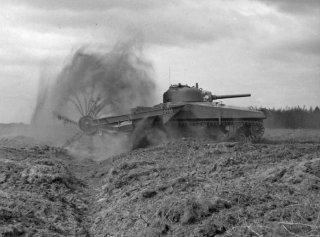This M4 Sherman Tank Tried to Pull Mine Clearing Duty…But Failed
High curb weight and low mobility significantly hurt the project’s progress.
The M4 Sherman tank is an icon of the Second World War. In many ways it was the everyman’s tank. It combined respectable firepower with good armor protection and decent off-road capabilities. A staggering number of Sherman’s were produced—nearly 50,000 units were built for service with the United States, and via Lend-Lease, many thousands ended up in service with the Soviet Union and with the Brits.
Quite a few variants of the tank were built as well and served in tank destroyer roles, as gun carriages, so-called zippo flamethrower tanks, and some were even modified as engineer vehicles or as recovery vehicles. This particular variant however was used to clear minefields.
Mine Clearing Duty
Most mine clearing vehicles today use heavy lengths of steel chain to whip or flail mines out of the way or to make them detonate. Long arms whip chains around and dig hidden explosives out of the ground. No so with this Sherman variant though.
Rather than chain, this tank used sheer weight to set off enemy mines buried in the ground. At the front of the tank, enormous steel wheels were used in place of tank treads. The wheels were quite wide, to cover a larger path of ground in front of the tank, and very tall, around 96 inches, or about eight feet. They had large gaps in them as well to better disperse explosions in front of the tank.
At the rear a long row of discs were connected to create a roller that would set off mines that the two wheels missed, directly in the middle of the tank’s path and expanded the tank’s road coverage. In order to prevent the rear roller and front wheels from becoming clogged with mud and dirt, purpose-but metal starts were installed between the disk gaps to keep the space between and keep it debris-free.
The tank’s belly was strengthened with additional armor plating. While this increased the tank’s weight by quite a bit, it better protected the tank body, though no crew members were inside. The mine-busting tank was radio controlled, a nod to how dangerous it would have been inside the tank. Steering the tank was much likely easier said than done.
Somewhat inexplicably, the Sherman’s 76 millimeter main gun remained mated to the turret. An odd decision considering the tank wouldn’t have been manned and therefore couldn’t fire its main or secondary guns.
Postscript
Ultimately the roller-style method of setting off mines lost out to the chain-flail style of mine clearing—which is probably for the better. Still, the odd roller behemoth makes for an interesting prototype.
Caleb Larson is a Defense Writer with The National Interest. He holds a Master of Public Policy and covers U.S. and Russian security, European defense issues, and German politics and culture.
Image: Wikimedia

